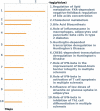RNA-seq transcriptome profiling of pigs' liver in response to diet with different sources of fatty acids
- PMID: 36816031
- PMCID: PMC9936315
- DOI: 10.3389/fgene.2023.1053021
RNA-seq transcriptome profiling of pigs' liver in response to diet with different sources of fatty acids
Abstract
Pigs (Sus scrofa) are an animal model for metabolic diseases in humans. Pork is an important source of fatty acids (FAs) in the human diet, as it is one of the most consumed meats worldwide. The effects of dietary inclusion of oils such as canola, fish, and soybean oils on pig gene expression are mostly unknown. Our objective was to evaluate FA composition, identify changes in gene expression in the liver of male pigs fed diets enriched with different FA profiles, and identify impacted metabolic pathways and gene networks to enlighten the biological mechanisms' variation. Large White male pigs were randomly allocated to one of three diets with 18 pigs in each; all diets comprised a base of corn and soybean meal to which either 3% of soybean oil (SOY), 3% canola oil (CO), or 3% fish oil (FO) was added for a 98-day trial during the growing and finishing phases. RNA sequencing was performed on the liver samples of each animal by Illumina technology for differential gene expression analyses, using the R package DESeq2. The diets modified the FA profile, mainly in relation to polyunsaturated and saturated FAs. Comparing SOY vs. FO, 143 differentially expressed genes (DEGs) were identified as being associated with metabolism, metabolic and neurodegenerative disease pathways, inflammatory processes, and immune response networks. Comparing CO vs. SOY, 148 DEGs were identified, with pathways related to FA oxidation, regulation of lipid metabolism, and metabolic and neurodegenerative diseases. Our results help explain the behavior of genes with differential expression in metabolic pathways resulting from feeding different types of oils in pig diets.
Keywords: RNA-Seq; liver; metabolic disease; metabolic diseases; neurodegenerative diseases; pig; transcriptome.
Copyright © 2023 Fanalli, Silva, Gomes, Durval, Almeida, Moreira, Silva-Vignato, Afonso, Freitas, Reecy, Koltes, Koltes, Garrick, Correia de Almeida Regitano, Balieiro, Mourão, Coutinho, Fukumasu, Alencar, Luchiari Filho and Cesar.
Conflict of interest statement
The authors declare that the research was conducted in the absence of any commercial or financial relationships that could be construed as a potential conflict of interest.
Figures






References
-
- Almeida V. V., Silva J. P. M., Schinckel A. P., Meira A. N., Moreira G. C. M., Gomes J. D., et al. (2021). Effects of increasing dietary oil inclusion from different sources on growth performance, carcass and meat quality traits, and fatty acid profile in genetically lean immunocastrated male pigs. Livest. Sci. 248, 104515. 10.1016/j.livsci.2021.104515 - DOI
-
- Benjamini Y., Hochberg Y. (1995). Controlling the false discovery rate: A practical and powerful approach to multiple testing. J. R. Stat. Soc. Ser. B 57, 289–300. 10.1111/j.2517-6161.1995.tb02031.x - DOI
LinkOut - more resources
Full Text Sources
Research Materials
Miscellaneous

